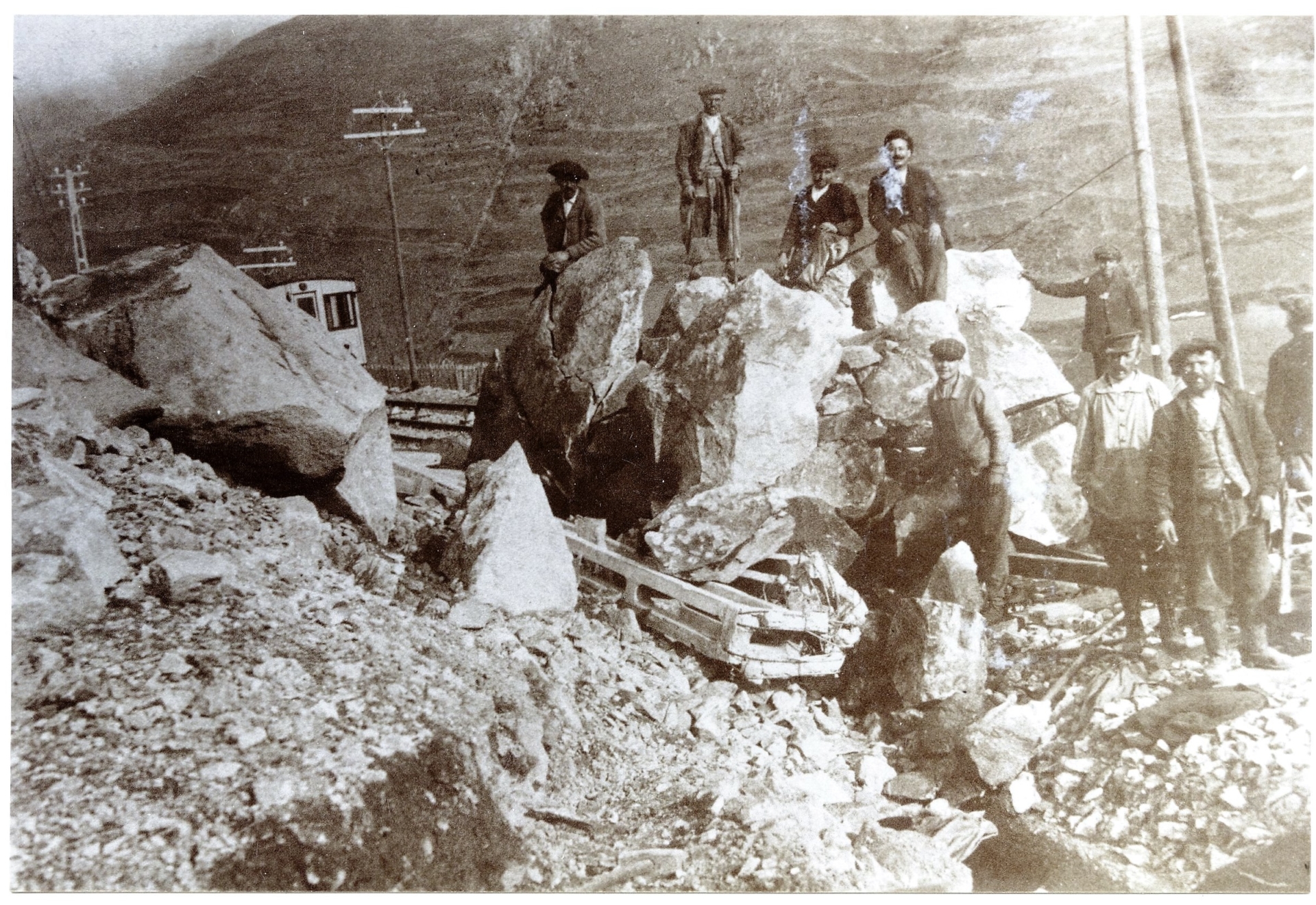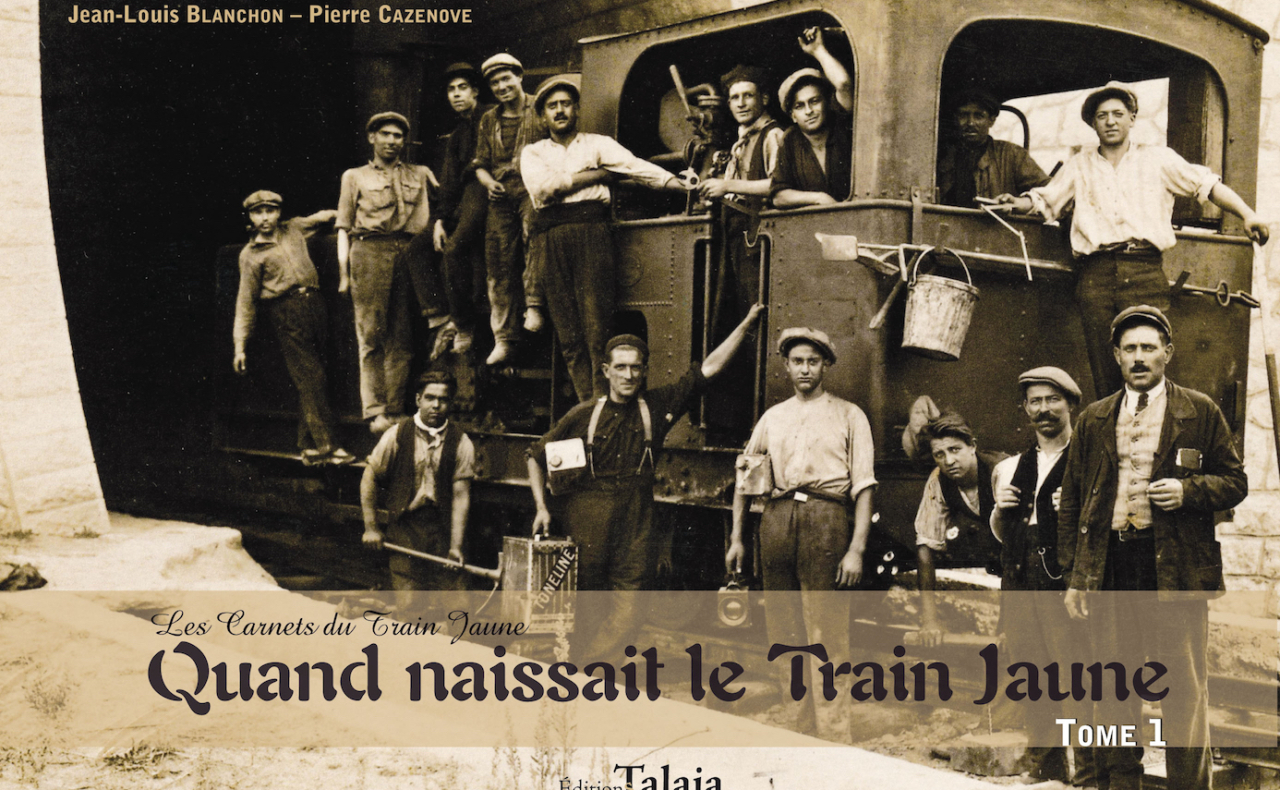With this new event highlighting the” Les carnets du Train Jaune ” collection, the Parc Naturel Régional des Pyrénées Catalanes offers a retrospective, a journey back in time through the construction of the Yellow Train line and its history. This collection is the result of a collaboration between the Parc Naturel Régional des Pyrénées Catalanes and historians Pierre Cazenove and Jean-Louis Blanchon, co-published with Editions Talaïa.
In the second part of the story, conversations were lively in the wake of the Paillat accident, but the work continued nonetheless…
Line opening Part 1 – Villefranche / Mont-Louis
The Villefranche / Mont-Louis project was just waiting for the minister’s go-ahead. Between Mont-Louis and Bourg-Madame, workers were ballasting and laying the track. The Cerdanya region soon learned that the line would open on 1 July 1910. Unfortunately, melting snow and rain caused several landslides on the RN 116, as well as between Olette and Nyer and near the Gisclard bridge. The following month, in June, further landslides swept away or damaged the 3rd rail and high-voltage line over some distance.
Operations were therefore delayed until 18 July 1910, when public enthusiasm exploded all along the line. César Boyer, correspondent for L’indépendant wrote on that day : «It’s a patient, safe and deliciously treacherous climb to the Pyrenean high plateaux (…) We pass, in turn, Joncet station, clean as a new pin, Olette station, whose dapper garden in the sunshine wins general admiration, the Nyer route huddled near a viaduct in a comic opera setting, the Thuès-les-Bains route overlooking the torrent with its tumultuous waters ; we cross the Séjourné bridge, the Gisclard bridge, Fontpédrouse, and here we are at Mont-Louis / La Cabanasse station… »

The Compagnie du Midi still only had two railcars fitted with the electromagnetic brake required after the Paillat accident. They kept one in reserve and the other arrived from Mont-Louis at 7.15am with 20 passengers. It could carry 50, which couldn’t cater for the crowds waiting in Villefranche. Many people from Perpignan wanted to be at the opening ; the first four tickets issued to Mont-Louis were taken by Doctor Janicot, Pierre Deit, director of the Comptoir Céramique, René Badie, locksmith, and Aliet, butcher from Perpignan.
They were joined by Jules Lax, Bes de Berc, Malterre, Rivière, Garau, Marquebielle, Lhériaud, Achard, Delprat, Cullière, Bernard-Bernard, Emmannuel Brousse and his family, etc.
The whole region crowded along the track and into every station. In Mont-Louis, in a crowded train station, the cobla played La Marseillaise near the town council. Schoolchildren and Mr Rous, a teacher from La Cabanasse, frantically waved small French flags and raised bouquets. The train stopped ; the mayor, Mr Delcasso, brought the inevitable speech to a standing ovation ; schoolchildren sang well-received choruses. During the reception, at Café du Pont, a thousand toasts were made, including : « Let’s raise our glasses, gentlemen ! As Catalans, let us drink to the prosperity of our high-altitude district As Frenchmen, let us drink to the greatness of the Republic ! »
At 10.48am, the second train of the day returned to Villefranche. At 3.00pm, after coffee at Grand café de la gare, the cobla played Le chant du départ as the third and final train departed. All day long, there was nothing but music, dancing and cries to the glory of Brousse and Lax. In the evening, fireworks lit up the heights above the station. The party went on late into the night. Cerdanya celebrated ; it was a great day for Brousse and Lax ; Jules Escarguel recalled that they dared to call them murderers after the Gisclard accident, and that Dalbiez accused them « of having poured millions from the national budget into our department. »
The line was an immense success. Mont-Louis station was always busy. There were 180 passengers on 23 July. The train was so crowded that the stagecoach had to continue its service !

On 6 August 1910, Emmanuel Brousse managed to commission two self-propelled railcars. Osséja was expecting an exceptional season and even feared a shortage of available accommodation.
On 15 August, the railways issued half-price tickets. 122 passengers squeezed into the morning train. Hotels had to turn people away. In its first month of operation, 30,000 passengers passed through Mont-Louis station. Some continued on to Bourg-Madame by car (5 F per seat).
« The people of Cerdanya » were too overjoyed to worry about a few hiccups : a landslide at the entrance to the Gisclard bridge in September, a derailment at Planès in March 1911, a landslide between Thuès and Planès in April, and a stoppage due to lack of power at the end of that month.
More cruel was the accident involving Pierre Bolo, an electrical worker from Axat. In September 1910, in Villefranche, he put his hand on the 3rd rail and died of electrocution.
At first, the train carried only passengers. In November 1910, after many complaints, everyone was overjoyed to see freight cars appear.
Book extract
Les Carnets du Train Jaune
Volume 1 – When the Yellow Train was born
authors: Jean-Louis Blanchon / Pierre Cazenove
Parc Naturel Régional des Pyrénées-Catalanes / Editions Talaia
June 2012
Complete collection available for consultation and/or sale at Maison du Parc Naturel Régional des Pyrénées-Catalanes, in Olette (66360, La Bastide).
